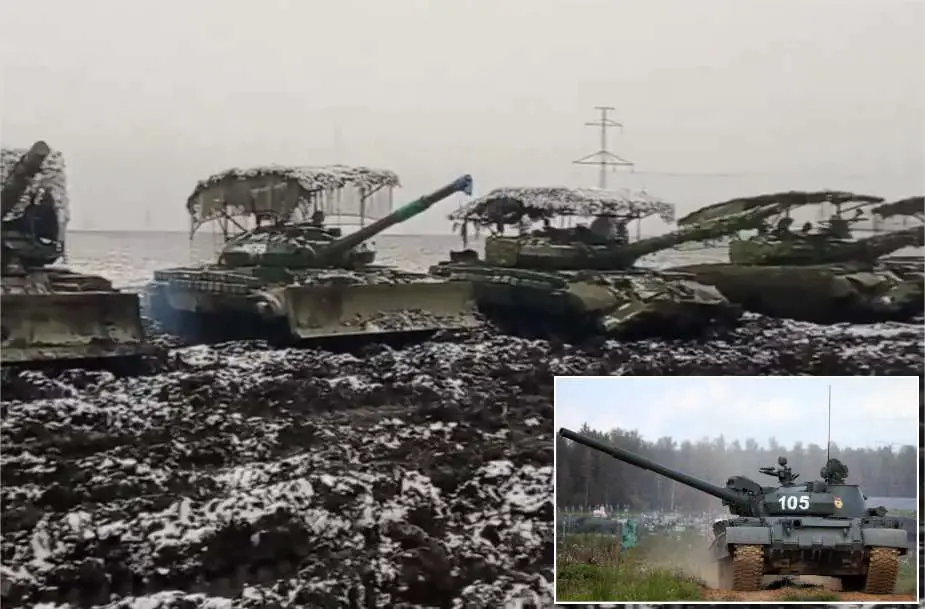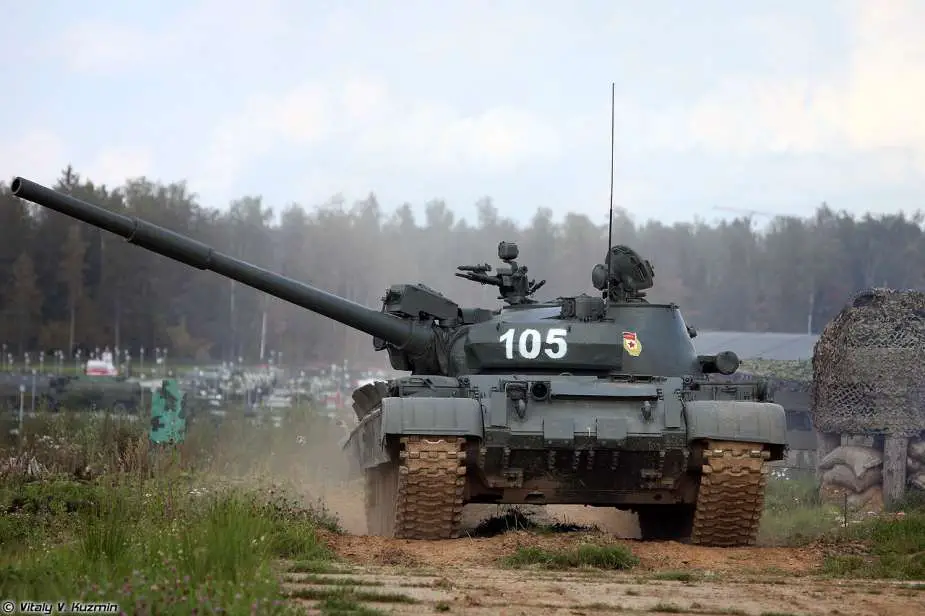- Army
- Conflicts in the world
- Israel - Iran conflict 2025
- Pakistan - India Conflict 2025
- Russia Ukraine War 2022
- Libya conflict day by day
- HAMAS - Israel War 2023
- Operation Serval in Mali French Army
- Sangaris operation Central African Republic
- Sangaris opération militaire République Centreafrique
- Ukraine - Russia conflict
- Syria conflict news
- Defence & Security Industry Technology
- Armies in the world
- Analysis Defense and Security Industry
- Conflicts in the world
- Navy
- Air
Russia keeps upgrading Soviet-era T-62M and T-62MV tanks for combat in Ukraine
On February 12, 2024, a video shared on Russian media details updates to the T-62M and T-62MV tanks, which are in use by Russia's Buryat 5th Separate Guards Tank Brigade, part of the 36th Combined Arms Army active in the Donetsk Oblast sector of southern Ukraine. It's also possible that these tanks could be linked to the 39th Separate Motorised Rifle Brigade, following the abandonment of a T-62M near Novomykhailivka, Donetsk Oblast.
Follow Army Recognition on Google News at this link

The upgrades to the T-62M tanks include Explosive Reactive Armor (ERA), jamming systems, and dozer blades. (Picture source: Russian social media and Vitaly Kuzmin)
The video reveals enhancements including the application of Explosive Reactive Armor (ERA) on the tanks' frontal hull, sides, and, for the MV variant, the turrets. Additions aimed at drone countermeasures are visible, such as anti-drone screens and camouflage nets, alongside electronic warfare systems intended to disrupt drone targeting operations, including against kamikaze drones.
The RP-377 EW system is specifically mentioned, utilized by Russian forces to counter Ukrainian ground-attacking FPVs, including kamikaze and bomber drones. Despite this, Ukrainian operators have reportedly developed methods to circumvent the RP-377’s jamming capabilities, possibly through frequent adjustments of their control frequencies.
Furthermore, the footage shows that three tanks have been equipped with a dozer blade, intended for use in various engineering tasks such as creating shelters, clearing debris, filling ditches, and moving damaged equipment. These modifications have increased the weight of the tanks by several tons, purportedly three tons for the T-62MV, necessitating more powerful engines to sustain or enhance mobility. This claim about engine upgrades, provided by Russian sources, has not been independently verified, though it suggests an attempt to compensate for the added weight given the original diesel engine's 620 horsepower output.
Improvements to night combat capabilities are also highlighted, with the integration of 1PN96MT-02 thermal imaging sights, designed to allow for precise target engagement under low-light conditions.
In March 2023, Russian military expert Konstantin Sivkov noted the strategic deployment of T-62 tanks in Ukraine, driven by an abundant supply of 115 mm caliber shells and the historical production of about 20,000 T-62 tanks by the USSR. These tanks are utilized as self-propelled artillery units, equipped to fire 9M117M1-2 Arkan anti-tank missiles, enabling them to engage enemy targets, including Western models, at distances up to 6 km.
Despite originating from the Soviet era, the T-62 has undergone numerous updates to remain functional in current conflicts, such as the war in Ukraine. Nonetheless, the tank faces several challenges, including a lack of ERA on some models, making them more susceptible to anti-tank projectiles. Compared to the advanced weaponry provided to the Ukrainian Army by the USA and NATO, the T-62, even after upgrades, is considered outdated. Its efficacy against contemporary anti-tank weapons has been questioned, raising concerns about its capability in modern combat situations.
The reactivation of T-62s by Russia is attributed to significant losses and maintenance challenges of more modern tanks, exacerbated by issues like pervasive corruption within the military infrastructure. Despite these hurdles, the T-62 is easy to upgrade, as many versions benefit from several upgrades, including additional armor protection, slat armor, a Tucha smoke grenade launcher, and the Soda anti-napalm system. Its lower maintenance requirements and operational costs, compared to newer models like the T-72 and T-90, present a practical option for certain operational scenarios.
Finally, despite its age, the modernized T-62s are not outmatched by every weapon used in the Ukraine conflict. Enhanced with Kontakt-5 or Relikt explosive reactive armor and latest-generation thermal sights, among other subsystems, these tanks could even perform significantly better than unmodernized T-72s.

The T-62M was developed during the late 1970s and early 1980s to counter advancements in Western tank technology. (Picture source: Vitaly Kuzmin)
The T-62M is an upgrade of the Soviet-era T-62 main battle tank, developed in the late 1970s and early 1980s to enhance its capabilities in response to Western tank developments. This upgrade targeted improvements in the tank's firepower, protection, and mobility. Notably, the T-62M was equipped with a new 115mm gun capable of firing anti-tank guided missiles (ATGMs) through the barrel, alongside applique armor and rubber side skirts for improved protection. The engine was also upgraded to enhance the tank's mobility. These modifications were intended to extend the operational life of the T-62 by addressing critical performance aspects, ensuring it remained functional in various combat scenarios.
Additional upgrades included the integration of a laser rangefinder, night vision equipment, and an enhanced fire control system to increase the tank's effectiveness on the battlefield. Some variants of the T-62M were outfitted with explosive reactive armor (ERA) for additional defense against anti-tank weaponry. These enhancements were part of a broader Russian strategy to maintain the utility of older tank models through systematic upgrades. Although the T-62M has been surpassed by more modern tanks in current military inventories, it continues to serve in several countries, illustrating the impact of these upgrades on extending its serviceability.
The T-62M Obr. 2020 upgrade aimed to further improve the T-62M, focusing on enhancements in armor, firepower, and mobility to adapt to modern combat environments. This iteration likely includes additional armor for better protection, upgraded fire control systems for increased accuracy, and possibly improved engines and suspension systems for enhanced mobility. The specifics of the T-62M Obr. 2020 upgrade are not widely detailed, but it is assumed to continue the trend of bolstering the tank's defensive and offensive capabilities. The inclusion of features such as explosive reactive armor (ERA) and advanced sighting equipment suggests an effort to keep the T-62M competitive against contemporary threats, demonstrating a commitment to updating older platforms to meet current operational demands.
The last variant of the T-62M, the T-62M Obr. 2022 was tailored for the ongoing conflict in Ukraine, and introduced a new thermal sight (1PN96MT-02) to improve targeting capabilities but did not include explosive reactive armor. This update, made against a backdrop of substantial losses of Russian armored vehicles, represents an attempt to augment the tank's effectiveness using available technology. However, the absence of modern protective upgrades like ERA and the reliance on older platforms have led to skepticism regarding the upgrade's impact on combat effectiveness, especially when contrasted with advanced Western-supplied weaponry to Ukraine.
The T-62MV is an upgraded version of the Soviet-era T-62M main battle tank, featuring enhancements aimed at improving its defensive and operational capabilities. The upgrades introduced in the 1980s include the addition of explosive reactive armor (ERA) to enhance defense against anti-tank guided missiles and RPGs, an updated fire control system to improve targeting accuracy, and a stronger engine to boost mobility. The tank maintains its 115mm gun, supplemented with a laser rangefinder and advanced ammunition types to adapt to the 1980s battlefield dynamics.
The T-62MV Obr. 2020 is a further update of the T-62MV, reflecting adjustments to meet the constraints of actual warfare. Initiated before the invasion of Ukraine, this modernization encompasses the integration of digital systems, enhanced communication equipment, and potential upgrades in armor and firepower. While specific details of the modifications may be limited, the focus is on increasing the tank's effectiveness in current conflict environments, with an emphasis on survivability, lethality, and compatibility with network-centric operations. The update seeks to extend the service life of the platform by providing a cost-effective solution for secondary military roles or exports.
Finally, one could suggest, with a hint of irony, that Russia's actual tank strategy seems to lean towards upgrading tanks that might seem more at home in a museum than on the battlefield. This approach arguably comes across as more cost-effective than addressing the various challenges faced by the T-14 Armata, which remains elusive in terms of mass production. It appears there's a certain pragmatic charm in revitalizing these open-air stored relics, offering them a second lease on life with updates, rather than navigating the complexities and expenses associated with bringing a modern tank into full-scale service.

The upgrades introduced by the T-62MV include the addition of explosive reactive armor (ERA) to enhance defense against anti-tank guided missiles and RPGs. (Picture source: Vitaly Kuzmin)


























